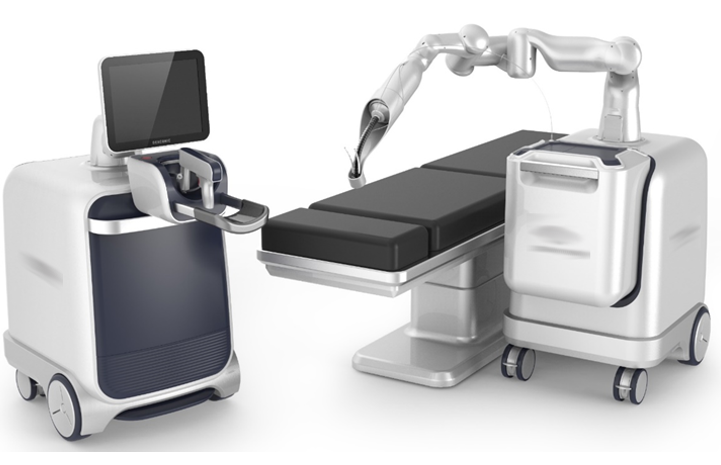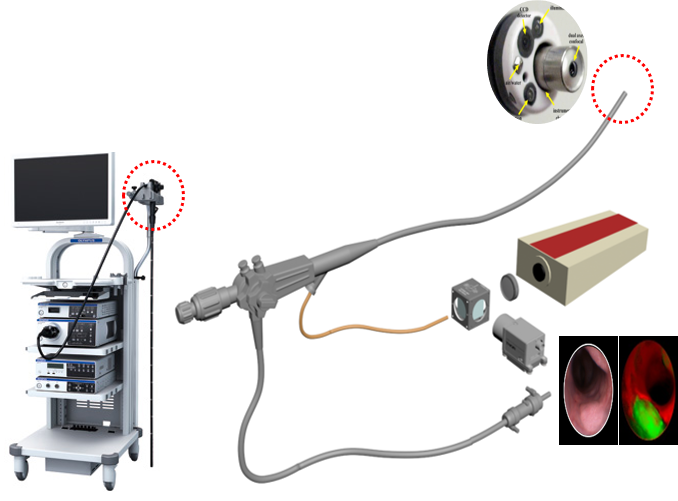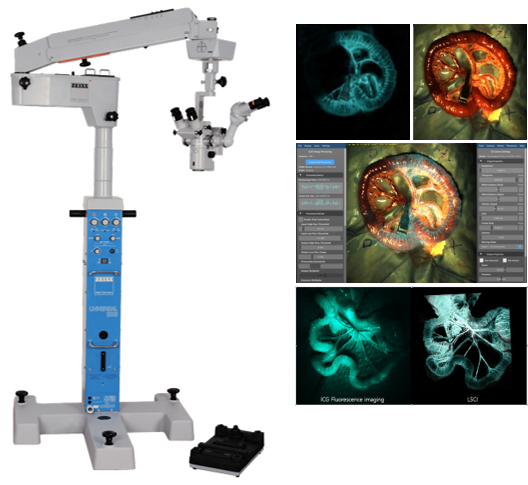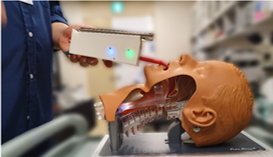Medical Device Development
Robotic surgical endoscopes

- High resolution single-port surgical robots
In collaboration with industry partners, we are providing the optical components for flexible high-resolution single-port surgical endoscopy robots. These include flexible endoscope probes with high-resolution optics capable of minimizing total endoscope diameter.
- Channel insertion endoscopy
Channels for instruments and biopsy sample extraction are common in commercial endoscope designs. We engineer flexible endoscopic probes and tools for this narrow geometry, maximizing their utility to medical practitioners.

Robotic surgical endoscopes

- High resolution single-port surgical robots
In collaboration with industry partners, we are providing the optical components for flexible high-resolution single-port surgical endoscopy robots. These include flexible endoscope probes with high-resolution optics capable of minimizing total endoscope diameter.
- Channel insertion endoscopy
Channels for instruments and biopsy sample extraction are common in commercial endoscope designs. We engineer flexible endoscopic probes and tools for this narrow geometry, maximizing their utility to medical practitioners.

Image-guided surgical devices

- Laser speckle contrast imaging
Diffuse scattering bodies such as cells can cause backscattering of coherent light. Based on the changes in this speckling over time, we can provide a “map” of the most dynamic areas of an imaged region to clinicians, highlighting such information as blood flow in tissue.
- Hyperspectral imaging
With information from the optical spectrum beyond the red, green, and blue which can be distinguished by the human eye, it is possible to make heretofore difficult diagnoses much simpler. We incorporate modern imaging sensors which can capture hyperspectral information into clinical microscopes and endoscopes, for applications such as distinguishing tissue oxygenation rates at a glance.
Image-guided surgical devices

- Laser speckle contrast imaging
Diffuse scattering bodies such as cells can cause backscattering of coherent light. Based on the changes in this speckling over time, we can provide a “map” of the most dynamic areas of an imaged region to clinicians, highlighting such information as blood flow in tissue.
- Hyperspectral imaging
With information from the optical spectrum beyond the red, green, and blue which can be distinguished by the human eye, it is possible to make heretofore difficult diagnoses much simpler. We incorporate modern imaging sensors which can capture hyperspectral information into clinical microscopes and endoscopes, for applications such as distinguishing tissue oxygenation rates at a glance.
Point-of-care medical applications
The future of affordable and practical medical care for the developing world depends on bringing technological advancements to rural areas at low cost. By designing portable endoscopes based on off-the-shelf parts which benefit from economies of scale, simplified diagnosis can be brought out of centralized hospitals and to the patient.

Point-of-care medical applications
The future of affordable and practical medical care for the developing world depends on bringing technological advancements to rural areas at low cost. By designing portable endoscopes based on off-the-shelf parts which benefit from economies of scale, simplified diagnosis can be brought out of centralized hospitals and to the patient.

*Selected papers:
- “Cost-Effective Smartphone-Based Articulable Endoscope Systems for Developing Countries: Instrument Validation Study” JMIR mHealth and uHealth Vol 8 (9), e17057, Sep, 2020
- “Multi-spectral fluorescence imaging of colon dysplasia in vivo using a multi-spectral endoscopy system,” Translational Oncology, Vol 12 (2), 226-235, Feb. 2019.
- “Tracking the fate of porous silicon nanoparticles delivering a peptide payload by intrinsic photoluminescence lifetime,” Advanced Materials, Vol 30(35). 1802878, Aug. 2018.
- “Fluoroscopic removal of retrievable self-expandable metal stents in patients with malignant oesophageal strictures: Experience with a non-endoscopic removal system,” European Radiology, Vol. 27, pp. 1257-1266, Jan. 2017.
- “Micro and nano optics over hybrid optical probes,” pp. 1-113, ISBN: 978-3-659-79904-4, LAP Lambert Academic Publishing, VDM publishing group, Saarbrücken, Germany, December, 2015.
- “In vivo imaging of tracheal epithelial cells in mice during airway regeneration,” American Journal of Respiratory Cell and Molecular Biology(AJRCMB), Vol. 47, No.6, pp.864-868, Dec. 2012. (Most-read Article during Oct. 2012)
* Selected papers:
- “Cost-Effective Smartphone-Based Articulable Endoscope Systems for Developing Countries: Instrument Validation Study” JMIR mHealth and uHealth Vol 8 (9), e17057, Sep, 2020
- “Multi-spectral fluorescence imaging of colon dysplasia in vivo using a multi-spectral endoscopy system,” Translational Oncology, Vol 12 (2), 226-235, Feb. 2019.
- “Tracking the fate of porous silicon nanoparticles delivering a peptide payload by intrinsic photoluminescence lifetime,” Advanced Materials, Vol 30(35). 1802878, Aug. 2018.
- “Fluoroscopic removal of retrievable self-expandable metal stents in patients with malignant oesophageal strictures: Experience with a non-endoscopic removal system,” European Radiology, Vol. 27, pp. 1257-1266, Jan. 2017.
- “Micro and nano optics over hybrid optical probes,” pp. 1-113, ISBN: 978-3-659-79904-4, LAP Lambert Academic Publishing, VDM publishing group, Saarbrücken, Germany, December, 2015.
- “In vivo imaging of tracheal epithelial cells in mice during airway regeneration,” American Journal of Respiratory Cell and Molecular Biology(AJRCMB), Vol. 47, No.6, pp.864-868, Dec. 2012. (Most-read Article during Oct. 2012)